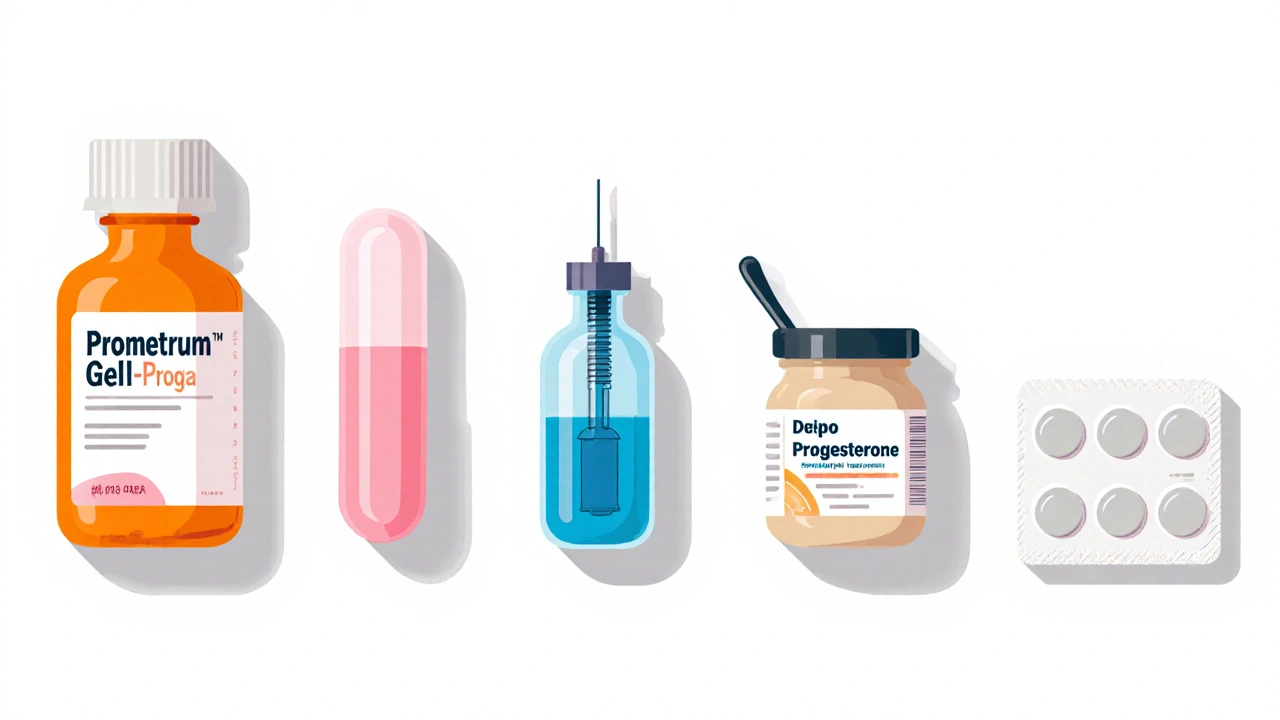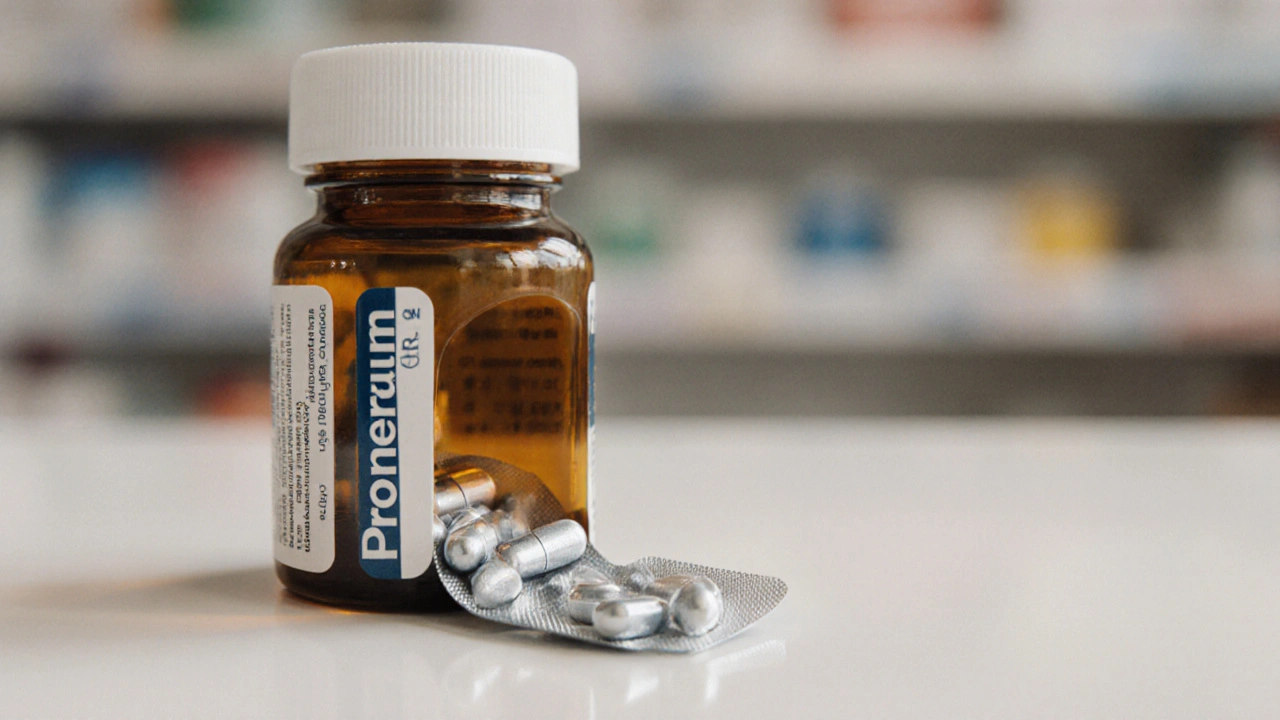Progesterone Option Selector
Personalized Progesterone Selection
Select your key factors to find the progesterone delivery method that best fits your needs.
When you start looking at hormone replacement therapy (HRT), Prometrium is often the first oral micronized progesterone that pops up in pharmacy aisles and online formularies. It’s a synthetic version of the body’s own Progesterone, designed to mimic the natural hormone’s timing and shape during a menstrual cycle.
Why Compare? The Real‑World Jobs You Want Done
- Decide whether an oral pill fits your lifestyle better than a vaginal gel, injection, or skin‑applied product.
- Understand the potency and side‑effect profile of each alternative.
- Match the cost and insurance coverage of each option to your budget.
- Identify which form works best for specific clinical scenarios (e.g., luteal‑phase support, menopausal bleeding, infertility).
- Know the key safety warnings to avoid drug interactions or contraindications.
Key Players in the Progesterone Landscape
Below is a quick snapshot of the most common progesterone‑based products you’ll encounter.
- Prometrium - micronized oral capsule, 100‑200mg per day.
- Crinone - vaginal gel, 8% progesterone, typically 90mg nightly.
- Duphaston - synthetic dydrogesterone tablet, 10‑20mg per day.
- Depo‑Provera - intramuscular medroxyprogesterone acetate injection, 150mg every 12‑13 weeks.
- Compounded Progesterone cream - topical 10‑20% formulation, applied twice daily.
- Compounded Progesterone patch - transdermal delivery, usually 100mg/day.
Side‑Effect Profile at a Glance
The same hormone can feel very different depending on how it’s delivered. Oral capsules travel through the liver first (first‑pass metabolism), which can cause more drowsiness or nausea. Vaginal gels bypass the liver, leading to steadier blood levels but sometimes local irritation. Injections give a long‑acting spike that may cause weight gain or mood swings. Creams and patches deliver low‑dose hormone through the skin-great for “gentle” therapy, yet absorption varies widely between individuals.

Comparison Table
| Form | Brand | Typical Dose | Route | Bioavailability | Common Use | Pros | Cons |
|---|---|---|---|---|---|---|---|
| Micronized Oral Capsule | Prometrium | 100‑200mg daily | Oral | ≈30% (first‑pass) | Menopausal HRT, luteal‑phase support | Convenient, widely covered by insurance | Nausea, drowsiness, liver metabolism |
| Vaginal Gel | Crinone | 90mg nightly | Vaginal | ≈80% (no first‑pass) | IVF luteal support, endometrial preparation | Steady serum levels, low systemic side‑effects | Local irritation, messier application |
| Synthetic Tablet | Duphaston | 10‑20mg daily | Oral | ≈50% | Premenstrual syndrome, menstrual disorders | Long shelf‑life, less oily | May not be fully "bioidentical", limited in some countries |
| Injectable Ester | Depo‑Provera | 150mg every 12‑13 weeks | Intramuscular | ≈100% (bypasses liver) | Contraception, endometrial cancer therapy | Very long‑acting, good adherence | Weight gain, mood changes, injection site pain |
| Topical Cream | Compounded Progesterone Cream | 0.5‑1g twice daily (≈10‑20% strength) | Skin | Variable (10‑30%) | Menopausal symptoms, sleep aid | Non‑invasive, easy to dose | Inconsistent absorption, may need trial‑and‑error |
| Transdermal Patch | Compounded Progesterone Patch | 100mg/24h | Skin | ≈30‑40% | Continuous delivery for HRT | Steady dosing, no daily pill | Skin irritation, limited commercial options |
Decision‑Making Checklist
- How often can you remember to take it? If daily pills feel cumbersome, a patch or injection might win.
- Do you have liver concerns? Oral Prometrium passes through the liver; vaginal or injectable routes avoid that.
- Is cost a deal‑breaker? Insurance usually covers Prometrium and Depo‑Provera, while creams and patches often require out‑of‑pocket spending.
- What’s the therapeutic goal? For IVF luteal support, many clinics prefer vaginal gel; for chronic menopausal symptoms, oral or transdermal may be smoother.
- Any medication interactions? Oral progesterone can interact with CYP3A4 inducers/inhibitors; injectable forms have fewer interactions.
Real‑World Scenarios
Scenario 1 - A 52‑year‑old post‑menopausal woman with hot flashes. She wants a simple daily routine and her insurance covers oral meds. Prometrium 100mg nightly combined with estradiol patches offers an easy, cost‑effective plan.
Scenario 2 - A 34‑year‑old undergoing IVF. Her reproductive specialist recommends nightly vaginal gel (Crinone) because it delivers higher local progesterone to the uterus without systemic side‑effects. If she dislikes the gel, an oral microndized pill can be a backup, though the success rates may differ.
Scenario 3 - A 45‑year‑old with a history of liver disease. The doctor opts for a quarterly injection of Depo‑Provera to bypass hepatic metabolism entirely.

Potential Pitfalls & How to Avoid Them
- Skipping doses. Oral formulations lose efficacy quickly; set a reminder or use a pill organizer.
- Assuming “natural” equals safe. Compounded creams may contain contaminants; source them from reputable pharmacies.
- Ignoring drug interactions. CYP450 inducers (e.g., certain antiepileptics) can lower oral progesterone levels.
- Over‑relying on cost alone. Cheaper alternatives sometimes lack clinical evidence; balance price with proven outcomes.
Bottom Line: Which One Wins?
There’s no one‑size‑fits‑all answer. If you need a low‑maintenance, widely reimbursed option, Prometrium is the go‑to oral pill. For IVF or precise endometrial preparation, Crinone is hard to beat. When you want a long‑acting schedule with minimal daily thought, Depo‑Provera shines, but watch for metabolic side‑effects. Dydrogesterone tablets (Duphaston) sit in the middle-oral, but chemically distinct from natural progesterone, making them useful where bioidentical options aren’t available.
Frequently Asked Questions
Is Prometrium truly bioidentical?
Yes. Prometrium contains micronized progesterone that is chemically identical to the hormone produced by the ovaries. The micronization process improves absorption, but the molecule itself matches the natural hormone.
Can I switch from an injection to an oral pill without a wash‑out period?
Usually a short overlap is advised. Because injectable medroxyprogesterone acetate stays in the system for weeks, doctors often wait 2-3 weeks after the last shot before starting oral therapy to avoid excess progesterone levels.
Which option is best for someone with severe nausea on oral meds?
A vaginal gel (Crinone) or a transdermal patch can bypass the gastrointestinal tract, dramatically reducing nausea.
Are compounded progesterone creams safe?
When sourced from a licensed compounding pharmacy with Good Manufacturing Practices, they are generally safe. However, potency can vary, so regular blood level checks are recommended.
How does cost compare among these options?
Oral Prometrium and Depo‑Provera are typically covered by public and private insurers in many countries. Vaginal gels, creams, and patches often require out‑of‑pocket payments ranging from $30 to $150 per month, depending on brand and insurance.

Mike Rylance
October 14, 2025 AT 12:28Thank you for assembling such a comprehensive comparison; it really helps patients navigate the often confusing landscape of progesterone therapies. The side‑effect tables and cost considerations are particularly valuable for anyone trying to balance efficacy with insurance coverage.
Becky B
October 21, 2025 AT 11:08The pharma giants push Prometrium to keep you dependent, stay vigilant.
Aman Vaid
October 28, 2025 AT 08:48From a pharmacokinetic perspective, oral micronized progesterone such as Prometrium undergoes approximately 30% bioavailability due to first‑pass hepatic metabolism. In contrast, the vaginal gel Crinone bypasses the liver, achieving roughly 80% systemic absorption, which accounts for its steadier serum levels. The injectable depot form Depo‑Provera delivers medroxyprogesterone acetate intramuscularly, providing nearly 100% bioavailability and a prolonged half‑life of about 50 days. Topical creams exhibit highly variable absorption ranging from 10% to 30%, depending on the vehicle and skin integrity. When selecting a formulation, clinicians must weigh the metabolic load on hepatic enzymes, especially in patients concurrently using CYP3A4 inducers or inhibitors. Moreover, the half‑life of each preparation dictates dosing frequency and potential for accumulation; for instance, daily oral dosing requires strict adherence to avoid sub‑therapeutic peaks. Finally, insurance formularies often prioritize oral capsules, which may inadvertently steer patients toward less optimal routes for certain clinical scenarios such as IVF luteal support.
xie teresa
November 4, 2025 AT 07:28I appreciate the balanced tone; it’s reassuring to see both pros and cons laid out without bias.
Srinivasa Kadiyala
November 11, 2025 AT 06:08While many readers might assume that “natural” automatically equals “safe”; however, the distinction between bioidentical and synthetic compounds, such as dydrogesterone in Duphaston, warrants careful scrutiny; additionally, the route of administration fundamentally alters the pharmacodynamic profile; for example, vaginal applications avoid hepatic first‑pass metabolism, thereby reducing systemic side‑effects, yet they introduce local irritation, which can affect compliance; conversely, oral formulations, though convenient, may trigger nausea or drowsiness due to hepatic processing, especially in patients with pre‑existing liver concerns; finally, cost considerations are not merely about the sticker price-insurance coverage, formulary restrictions, and out‑of‑pocket thresholds all play pivotal roles in real‑world decision‑making.
Alex LaMere
November 18, 2025 AT 04:48Fact‑check: oral progesterone undergoes first‑pass metabolism; note the pharmacokinetics. 👍
Dominic Ferraro
November 25, 2025 AT 03:28Great job summarizing the options! If you’re looking for low maintenance, the injection really shines, but for those who dislike needles, the patch or cream can be a gentle alternative. Keep the conversation going!
Jessica Homet
December 2, 2025 AT 02:08Honestly, the oral pill is just a marketing ploy; anyone who’s tried the gel knows it’s way better.
KayLee Voir
December 9, 2025 AT 00:48When helping someone decide, I always start with the “how often can you remember” question-simple but effective. It narrows the field fast.